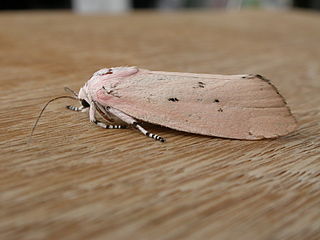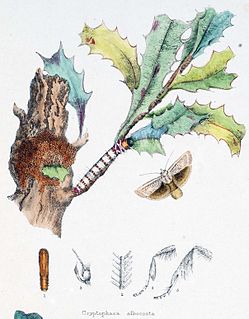Related Research Articles

Lichenaula tuberculata is a moth of the family Xyloryctidae. It is endemic to Australia, more specifically the Australian Capital Territory and New South Wales.

Plectophila discalis is a moth of the family Xyloryctidae first described by Francis Walker in 1865. It is found in Australia, where it has been recorded from New South Wales, Queensland and Victoria.
Batrachedra plagiocentra is a species of moth of the family Batrachedridae. It is found in Australia.

Cryptophasa hyalinopa is a moth of the family Xyloryctidae. It is known from Queensland, Australia.
Garrha cholodella is a moth in the family Oecophoridae. It was described by Edward Meyrick in 1883. It is found in Australia, where it has been recorded from New South Wales.
Garrha leucerythra is a moth in the family Oecophoridae. It was described by Edward Meyrick in 1883. It is found in Australia, where it has been recorded from New South Wales and Tasmania.
Prodelaca myodes is a moth in the family Oecophoridae. It was described by Edward Meyrick in 1883. It is found in Australia, where it has been recorded from Queensland and New South Wales.
Garrha sericata is a moth in the family Oecophoridae. It was described by Edward Meyrick in 1883. It is found in Australia, where it has been recorded from Queensland and New South Wales.

Cryptophasa delocentra is a moth in the family Xyloryctidae. It was described by Edward Meyrick in 1890. It is found in Australia, where it has been recorded from New South Wales and Queensland.
Cryptophasa sarcinota is a moth in the family Xyloryctidae. It was described by Edward Meyrick in 1890. It is found in Australia, where it has been recorded from Queensland.
Cryptophasa chionodes is a moth in the family Xyloryctidae. It was described by Turner in 1898. It is found in Australia, where it has been recorded from New South Wales and Queensland.
Cryptophasa eumorpha is a moth in the family Xyloryctidae. It was described by Turner in 1898. It is found in New Guinea and Australia, where it has been recorded from Queensland.
Cryptophasa nigricincta is a moth in the family Xyloryctidae. It was described by Turner in 1898. It is found in Australia, where it has been recorded from Queensland.
Cryptophasa psilocrossa is a moth in the family Xyloryctidae. It was described by Turner in 1902. It is found in Australia, where it has been recorded from Queensland.
Cryptophasa sacerdos is a moth in the family Xyloryctidae. It was described by Turner in 1902. It is found in Australia, where it has been recorded from Queensland.
Cryptophasa stenoleuca is a moth in the family Xyloryctidae. It was described by Oswald Bertram Lower in 1894. It is found in Australia, where it has been recorded from New South Wales, the Northern Territory, Queensland and Western Australia.
Cryptophasa ochroleuca is a moth in the family Xyloryctidae. It was described by Oswald Bertram Lower in 1892. It is found in Australia, where it has been recorded from the Australian Capital Territory, New South Wales, South Australia and Victoria.

Cryptophasa albacosta, the small fruit tree borer, is a moth in the family Xyloryctidae. It was described by John Lewin in 1805. It is found in Australia, where it has been recorded from New South Wales, Queensland, South Australia, Tasmania and Victoria.
Enchocrates picrophylla is a moth in the family Depressariidae. It was described by Edward Meyrick in 1886. It is found in Australia, where it has been recorded from South Australia and New South Wales.
Agriophara atratella is a moth in the family Depressariidae. It was described by Francis Walker in 1866. It is found in Australia, where it has been recorded from Queensland and New South Wales.
References
- ↑ Savela, Markku. "Cryptophasa balteata (Walker, 1866)". Lepidoptera and Some Other Life Forms. Retrieved February 4, 2018.
- ↑ Xyloryctine Moths of Australia
| This article on a moth of the family Xyloryctidae is a stub. You can help Wikipedia by expanding it. |